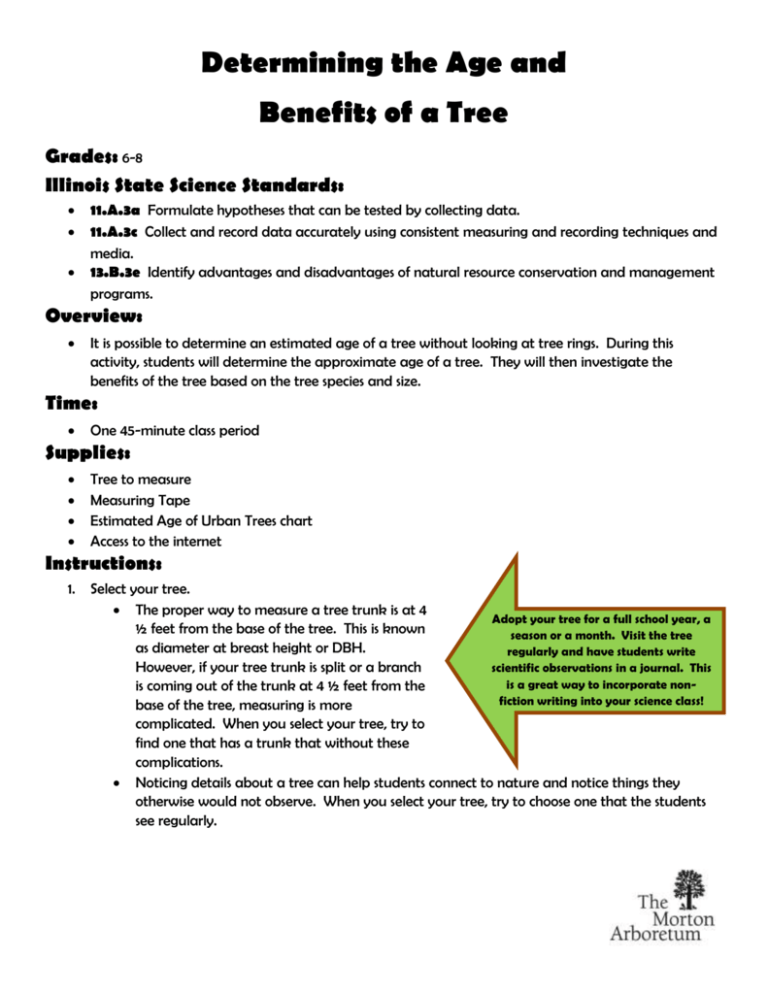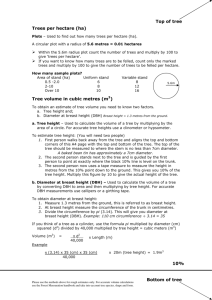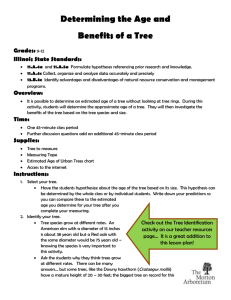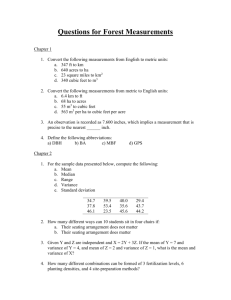Estimated 1 Age of Urban Trees by Species and Diameter (DBH)
advertisement

Determining the Age and Benefits of a Tree Grades: 6-8 Illinois State Science Standards: 11.A.3a Formulate hypotheses that can be tested by collecting data. 11.A.3c Collect and record data accurately using consistent measuring and recording techniques and media. 13.B.3e Identify advantages and disadvantages of natural resource conservation and management programs. Overview: It is possible to determine an estimated age of a tree without looking at tree rings. During this activity, students will determine the approximate age of a tree. They will then investigate the benefits of the tree based on the tree species and size. Time: One 45-minute class period Supplies: Tree to measure Measuring Tape Estimated Age of Urban Trees chart Access to the internet Instructions: 1. Select your tree. The proper way to measure a tree trunk is at 4 Adopt your tree for a full school year, a ½ feet from the base of the tree. This is known season or a month. Visit the tree as diameter at breast height or DBH. regularly and have students write However, if your tree trunk is split or a branch scientific observations in a journal. This is a great way to incorporate nonis coming out of the trunk at 4 ½ feet from the fiction writing into your science class! base of the tree, measuring is more complicated. When you select your tree, try to find one that has a trunk that without these complications. Noticing details about a tree can help students connect to nature and notice things they otherwise would not observe. When you select your tree, try to choose one that the students see regularly. 2. 3. 4. 5. Have the students hypothesize about the age of the tree based on its size. This hypothesis can be determined by the whole class or by individual students. Write down your predictions so you can compare these to the estimated age you determine for your tree after you complete your measuring. Identify your tree. Different tree species grow at different rates. An Check out the Tree American elm with a diameter of 15 inches is about 38 Identification Activity on years old but a Red oak with the same diameter would our teacher resources page! be 75 years old – knowing the species is very important to this activity. Ask the students why they think trees grow at different rates. There can be many answers… but some trees, like the Downy hawthorn (Crataegus mollis) have a mature height of 20 – 30 feet; the biggest tree on record for this species is 35 feet tall. While other trees, such as the Giant Sequoia (Sequoiadendron giganteum) have been measured as tall as 311 feet. Our state tree, the White Oak (Quercus alba) has been measured at 86 feet tall! Measure 4 ½ feet from the base of the tree. Have one student hold the measuring tape at the base of the tree. Have a second student hold the measuring tape vertically in a straight line up the tree. Have a third student put their finger – and hold it very still – marking 4 ½ feet up from the base of the tree. Measure the circumference of the tree. Have the third student continue to keep his/her finger on the tree. Have a fourth student wrap the measuring tape around the tree. Several other students can assist in making sure that the measuring tape is flat and straight. The fourth student (wrapping the measuring tape around the tree) should determine the circumference of the tree in inches. You will need to round to the closest ¼ inch. Determine the diameter based on your circumference measurement. Diameter can be determined by using the equation: Diameter (d) = circumference (c) / pi where pi-3.14 or d = c/3.14 For example, if your circumference is 31.5 inches, your equation would be: d = 31.5”/3.14 which means For a great follow up homework assignment, have students complete this activity with a tree in their neighborhood and calculate its’ benefits. d = 10.03” Round your number to the closest inch. With the above example, your DBH is rounded to 10 inches. 6. Determine the age of your tree. Determine the age of your tree by using the Estimated Age of Urban Trees by Species and Diameter at Breast Height chart. (For example, if you have a white pine with a 10” diameter, your tree is estimated at 26 years old.) 7. Calculate the benefit of your tree. Go to the following website: http://www.davey.com/ask-the-expert/tree-calculator/nationaltree-benefit-calculator.aspx Enter your zip code and click the “submit” button. Double check that the zip code and city are correct. Enter your tree information in the boxes on the left side of the screen. Read and discuss the information provided for your tree. Clicking the tabs at the top of the page will describe the benefits of your tree in more detail. White Oak Images from The Morton Arboretum Estimated1 Age of Urban Trees by Species and Diameter (DBH) Tree diameter (DBH) in inches Species 5" 10’’ 15" 20" 25" 30" 35" 40" 45" 50" 95 104 194 Estimated tree age in years American elm (4) Siberian elm (4) Hackberry (7) Honeylocust (4) Pear (3) Green ash (4) White ash (3) Silver maple (7) Boxelder maple (4) Sugar maple (4) Red maple (6) Black maple (7) Norway maple (4) London plane (3) White oak (3) Swamp white oak (3) Red oak (4) Bur oak (4) Pin oak (4) Lindens (6) Basswood (7) Ginkgo (3) Black walnut (6) Kentucky coffeetree (3) Catalpa (3) Baldcypress (3) Poplar (10) White pine (6) Scotch pine (4) White spruce (6) Blue spruce (6) 1 6 6 13 7 11 9 12 12 14 9 6 7 15 15 21 17 27 24 14 29 15 27 14 9 23 33 23 20 28 16 24 20 55 38 32 29 41 24 45 21 18 36 51 34 39 40 25 36 31 75 28 21 16 24 26 23 13 18 28 26 52 39 30 38 31 31 35 41 36 21 29 41 38 68 61 45 48 39 50 52 34 63 28 31 50 70 58 46 77 63 67 53 109 73 77 59 86 65 84 94 83 35 46 64 88 104 126 148 171 65 78 107 86 110 136 64 52 33 94 63 127 94 134 46 41 51 112 140 130 144 146 148 162 152 53 76 104 28 36 52 61 69 77 84 82 95 107 119 Estimates are approximate given the significant variation in the growth rates of individual urban trees. (#) = source of information for the species. See accompanying page of citations. Citations for the Table “Estimate age of urban trees by special and diameter (DBH).” 1. de Vries, Roelof E. 1987. A preliminary investigation of the growth and longevity of trees in Central Park. Unpublished MS Thesis, Rutgers University, New Brunswick, NJ. 2. de Vries, Roelof E. 1985. Tree growth of selected species in Central Park. Unpublished Report May 6, 1985. 3. Dwyer, John F. 2010. Unpublished data on the growth of planted street trees in selected suburbs of Chicago. The Morton Arboretum, Lisle IL. 4. Dwyer, John F. 2009. How old is that tree? Illinois Trees: The quarterly publication of the Illinois Arborist Association. Vol. 24, Issue 6, Fall 2009 p. 13. 5. Fleming, Lynn E. 1988. Growth estimates of street trees in central New Jersey. Unpublished MS Thesis, Rutgers University, New Brunswick, NJ. 6. Frelich, Lee E. 1992. Predicting dimensional relationships for Twin Cities shade trees. Unpublished paper. Department of Forest Resources, University of Minnesota –Twin Cities, St. Paul MN. 7. Iakovoglou, Valasia. 2001. Trees examined along a rural-urban gradient and by local land use in the Midwestern US: An investigation of factors related to tree growth. Unpublished MS Thesis. Iowa State University, Ames Iowa. 8. Iakovoglou, Valasia; Thompson, Janette; Burras, Lee and Rebecca Kipper. 2003. Factors related to tree growth across urban-rural gradients in the Midwest, USA. Urban Ecosystems 5: 71-85. 9. Iakovoglou, Valasia; Thompson, Janette and Lee Burras. 2002. Characteristics of trees according to community population level and land us in the U.S. Midwest. Journal of Arboriculture 28, 59-69. 10. Nowak, David J. 1994. Atmospheric carbon dioxide reduction by Chicago’s urban forest. pp. 83-94 In: Chicago’s urban forest ecosystem: Results of the Chicago Urban Forest Climate Project. GTR NE-186. Radnor PA: U.S. Department of Agriculture, Forest Service, Northeastern Forest Experiment Station. 201 p.











